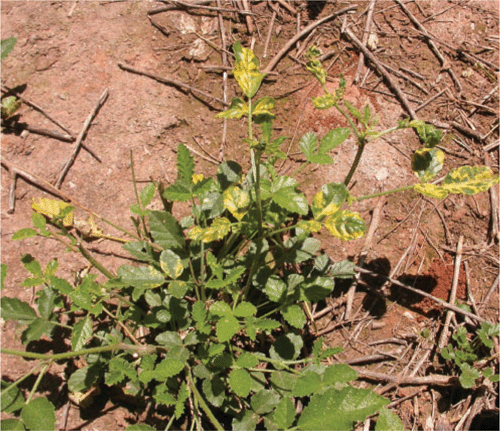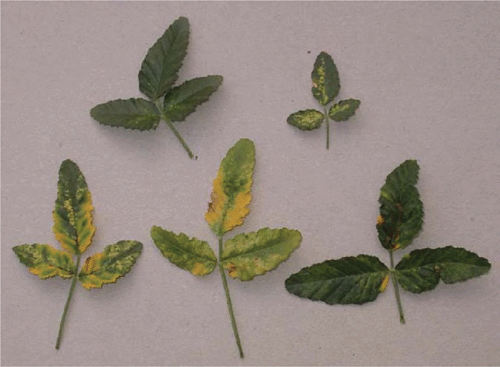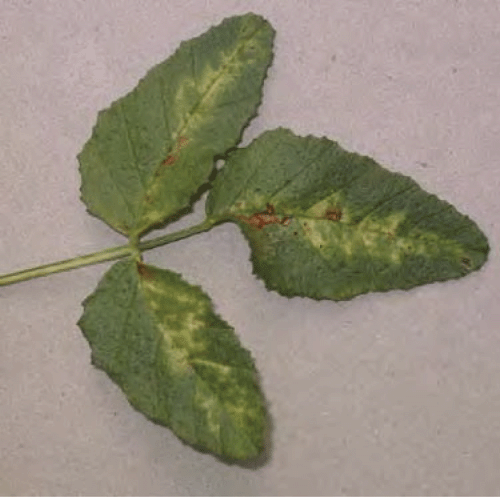Infection of Cullen australasicum (syn. Psoralea australasica) with Alfalfa mosaic virus
R. M. Nair A C , N. Habili B and J. W. Randles BA South Australian Research & Development Institute (SARDI), GPO Box 397, Adelaide, SA 5001, Australia.
B School of Agriculture, Food and Wine, The University of Adelaide, Waite Campus, PMB 1, Glen Osmond, SA 5064, Australia.
C Corresponding author. Email: madhavannair.ram@saugov.sa.gov.au
Australasian Plant Disease Notes 4(1) 46-48 https://doi.org/10.1071/DN09019
Submitted: 31 July 2008 Accepted: 20 April 2009 Published: 25 May 2009
Abstract
Severe yellow mosaic and leaf distortion symptoms have been observed on Cullen australasicum (cullen) plants growing in experimental plots at Urrbrae, South Australia. The incidence of the affected plants in a 2-year-old stand was ~80%. Symptom distribution on plants was uneven and symptom intensity appeared to vary between seasons. Alfalfa mosaic virus (AMV) was identified in 6/10 symptomatic and 1/10 asymptomatic field plants by reverse transcription-polymerase chain reaction (RT–PCR). Transmission of mosaic symptoms from cullen to cullen by mechanical inoculation was unsuccessful, but a cullen AMV isolate passaged through herbaceous indicators induced systemic mosaic in 1/4 of inoculated cullen seedlings. No seed transmission of AMV was observed in 50 seedlings raised from symptomatic parents. These results show that cullen is a host of AMV, but further studies are needed to determine whether AMV is the sole cause of the mosaic disease.
The potential of Cullen australasicum (Schltdl.) J.W. Grimes (syn. Psoralea australasica Schltdl.) (syn. cullen, native scurf-pea, native verbine) as a drought-hardy perennial legume for extensive grazing systems in southern Australia is currently being assessed (Dear et al. 2007, 2008). The target environments for this species include the low rainfall (<400 mm per annum) wheatbelt of southern Australia, where lucerne (Medicago sativa) fails to persist because of uncontrolled grazing and drought (Dear et al. 2007). We report here the identification of Alfalfa mosaic virus (AMV) in cullen plants grown in a seed production trial adjacent to a lucerne trial site at Urrbrae, South Australia during November 2007.
The incidence of plants showing leaf yellowing, mosaic, leaf rolling and stunting (Fig. 1) was ~80% in two blocks each of 5000 plants. Four affected plants were transplanted to the glasshouse and held at temperatures between 18°C and 25°C. All continued to express the same symptoms (Fig. 2), but new stems frequently produced asymptomatic leaves. Plants maintained in the field showed milder symptoms during early autumn 2008 compared with the previous spring.

|

|
Inoculum was prepared for mechanical transmission experiments by grinding young symptomatic leaves pooled from the four glasshouse plants in a chilled mortar and pestle, with ~2 volumes (w/v) of tap water. The following reactions were observed: systemic leaf distortion on Nicotiana benthamiana; mosaic and leaf distortion on N. clevelandii and N. glutinosa; chlorotic local lesions, systemic mosaic and stunting on Chenopodium quinoa; vein yellowing and mosaic symptoms on Pisum sativum cv. Dundale; systemic stunting and leaf rolling on P. sativum cv. Greenfeast; mosaic symptoms and systemic necrosis on Vicia faba; and necrotic local lesions on Phaseolus vulgaris cv. Brown Beauty. Local reactions were observed at 4–5 days after inoculation and systemic reactions commenced at 14 days. This host range and symptomatology is characteristic of AMV (Jaspars and Bos 1980). Mechanical inoculation from cullen to cullen was unsuccessful, but an inoculum combined from the symptomatic N. clevelandii and C. quinoa induced symptoms in one out of four inoculated cullen seedlings (Fig. 3).

|
Reverse transcription polymerase chain reaction (RT–PCR; MacKenzie et al. 1997) was used for diagnosis of AMV by amplifying a 422 bp portion of the AMV coat protein gene (Nair et al. 2008). We demonstrated that this assay could detect one infected cullen sample in the presence of nine uninfected samples and then used it for testing the seed transmissibility of AMV. Fifty seedling progeny raised from eight symptomatic cullen plants were assayed in the following groups: 5, 5, 5, 5, 5, 6, 8 and 11. None of the groups were positive for AMV. Seed transmission would thus be in the range 0–2% (Gibbs and Gower 1960).
To test the association between symptoms and detection of AMV, individual plants from the field were classified according to the expression of mosaic symptoms. Positive RT–PCR results were obtained for 6/10 symptomatic plants compared with 1/10 for asymptomatic plants. Of the four symptomatic plants which were negative by RT–PCR, the leaves that were assayed did not have mosaic symptoms. AMV infection has been reported to be latent or masked in some hosts and recovery often occurs (Jaspars and Bos 1980) and it is possible that the failure to detect the virus in these plants was due to lowered virus content in the sampled leaves. The RT–PCR detection threshold for AMV in cullen is not known and needs to be determined before examining the association between virus content and symptom expression. The positive result for the asymptomatic plant could either be the result of a new infection or a cyclical recovery from disease expression.
This is the first report that cullen is susceptible to AMV and that incidence of infection can be very high. The effect of the virus on the performance of cullen as a perennial pasture species needs to be evaluated. The high virus incidence observed in this South Australian field site is likely to be due to spread by aphid vectors from an outside source such as lucerne. We were unable to demonstrate rates of seed transmission in cullen that would alone explain this high incidence. Further work is needed to ascertain whether AMV is the sole causal agent of the mosaic disease.
Acknowledgements
We thank E. Kobelt, SARDI, for allowing access to his seed production trial and A. Humphries, SARDI, for recognising the disease.
Dear BS,
Li GD,
Hayes RC,
Hughes SJ,
Charman N, Ballard RA
(2007)
Cullen australasicum (syn. Psoralea australasica): a review and some preliminary studies related to its potential as a low rainfall perennial pasture legume. The Rangeland Journal 29, 121–132.
| Crossref | GoogleScholarGoogle Scholar |

Dear BS,
Reed KM, Craig AD
(2008) Outcomes of the search for new perennial and salt tolerant pasture plants for southern Australia. Australian Journal of Experimental Agriculture 48, 578–588.
| Crossref | GoogleScholarGoogle Scholar |

Gibbs AJ, Gower JC
(1960) The use of multiple transfer method in plant virus transmission studies – some statistical points arising in the analysis of results. The Annals of Applied Biology 48, 75–83.
| Crossref | GoogleScholarGoogle Scholar |

MacKenzie DJ,
McLean MA,
Mukerji S, Green M
(1997) Improved RNA extraction from woody plants for the detection of viral pathogens by reverse transcription-polymerase chain reaction. Plant Disease 81, 222–226.
| Crossref | GoogleScholarGoogle Scholar |
CAS |

Nair RM,
Peck DM,
Dundas IS,
Samac DA,
Moore A, Randles JW
(2008) Morphological characterisation and genetic analysis of a bi-pistil mutant (bip) in Medicago truncatula Gaertn. Sexual Plant Reproduction 21, 133–141.
| Crossref | GoogleScholarGoogle Scholar |



